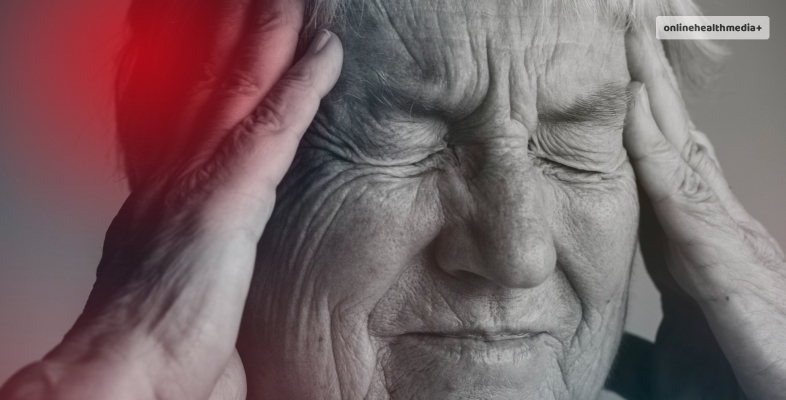What Is Dementia? Answered: Progress, Diagnosis And Treatment.
Note: The information in this article is not intended to substitute professional medical advice, diagnosis or treatment. All images and text presented are for general information purposes only. Contact your healthcare provider if any of the information is relatable.
Wondering, “What is Dementia?” Here’s your answer! It is a progressive neurological condition that affects cognitive function, memory, behavior, and the ability to perform daily activities.
It is not a specific disease but a group of symptoms demonstrating a decline in brain function. Dementia mostly affects older adults, but it also occurs in younger individuals.
This may be due to certain medical conditions or genetic factors.
“What is Dementia?” has recently been asked most after several celebrities received a diagnosis. This shows a prominent and direct sign of the condition having stronger effect on elderly people’s cognition.
This informative article looks into the types of dementia, its signs and the various treatment options. The article also focuses on the warning signs, how doctors diagnose the condition and other related information.
Contents
What Is Dementia And Its Types

Thinking “how many types of dementia are there?” There are several types of dementia, each with its own underlying causes and characteristic symptoms:
- Alzheimer’s Disease: Alzheimer’s disease is the most common type of dementia, accounting for approximately 60-80% of cases. It is characterized by the accumulation of abnormal protein deposits in the brain. This results in the gradual deterioration of brain cells and cognitive decline.
- Vascular Dementia: If you were asking “What is vascular dementia?” Then here’s your answer. Vascular dementia results from damage to blood vessels in the brain, typically caused by strokes or other vascular conditions. Symptoms may vary depending on the location and severity of the damage. However, it often includes difficulties with memory, judgment, and executive function.
Vascular dementia is the second most common type of dementia after Alzheimer’s disease. It results from reduced blood flow to the brain, often due to strokes.
Similarly, other vascular conditions such as high blood pressure, diabetes, or heart disease also lead to it.
Symptoms of vascular dementia may include difficulties with memory, attention, and executive function. In addition, mood changes and motor impairments.
- Lewy Body Dementia: Lewy body dementia is characterized by the presence of abnormal protein deposits called Lewy bodies in the brain. It shares symptoms with both Alzheimer’s disease and Parkinson’s disease. Additionally, cognitive impairment, visual hallucinations, and motor symptoms such as tremors and stiffness.
- Frontotemporal Dementia (FTD): FTD is a group of disorders characterized by progressive degeneration of the frontal and temporal lobes of the brain. It typically presents with changes in behavior, personality, and language, rather than memory impairment, in the early stages.
- Mixed Dementia: It refers to the presence of more than one type of dementia pathology in the brain. For example, Alzheimer’s disease and vascular dementia often coexist in individuals with mixed dementia.
Medications for Dementia
While there is currently no cure for dementia, medications may help manage symptoms. For instance, slow the progression of the disease in some cases.
If you are asking “what is the best medication for dementia?” Here’s the answer for one of the types of this condition:
The most common medications for Alzheimer’s disease include:
- Cholinesterase inhibitors (such as donepezil, rivastigmine, and galantamine) and
- Memantine
Both the conditions work by regulating neurotransmitters involved in memory and cognition.
How Fast Does Dementia Progress

The progression of dementia varies widely depending on the type of dementia, individual factors, and underlying causes.
In general, dementia is a progressive condition, meaning that symptoms tend to worsen over time. The rate of progression can range from several years to decades, with some individuals experiencing a rapid decline compared to others.
How Many Stages Of Dementia Are There?

Dementia is often categorized into several stages based on the severity of symptoms and their impact on daily functioning. While specific staging systems may vary, It is commonly classified into three stages:
- Early Stage: In the early stage, individuals may experience mild cognitive impairment and subtle changes in memory, language, or behavior. Symptoms may be noticeable to the individual and their loved ones but may not significantly interfere with daily activities.
- Middle Stage: The middle stage is characterized by more pronounced cognitive decline, including difficulties with memory, communication, and problem-solving. Individuals may require assistance with activities of daily living, such as dressing, grooming, and meal preparation.
- Late Stage: In the late stage, cognitive decline is severe, and individuals may lose the ability to communicate, recognize familiar faces, or perform basic tasks independently. They may require round-the-clock care and support to meet their needs.
What Are The 10 Warning Signs Of Dementia

Early detection of dementia is crucial for timely intervention and support. Some common warning signs of it include:
- Memory loss that disrupts daily life
- Difficulty completing familiar tasks
- Confusion about time, place, or identity
- Challenges with communication or language
- Poor judgment and decision-making
- Withdrawal from social activities
- Changes in mood or behavior
- Misplacing items and difficulty retracing steps
- Decreased or poor hygiene
- Difficulty following conversations or instructions
How Dementia Affects You
It is not a direct cause of death, but rather complications associated with the condition can lead to mortality.
Individuals with advanced dementia are at increased risk of developing complications such as:
- Infections (such as pneumonia or urinary tract infections),
- Malnutrition,
- Dehydration, And
- Falls, which can ultimately lead to death.
How To Diagnose Dementia?
Diagnosing dementia typically involves a comprehensive evaluation by a healthcare professional. It includes a medical history review, physical examination, cognitive assessments, laboratory tests, and brain imaging studies.
The diagnostic process aims to rule out other potential causes of cognitive impairment. Including determining the underlying type and severity of dementia.
Diagnosing dementia is a complex process that requires a comprehensive evaluation by a healthcare professional.
While there is no single test that can definitively diagnose dementia, a combination of medical history review, and physical examination.
Including cognitive assessments, laboratory tests, and brain imaging studies is typically used to make an accurate diagnosis. Let’s explore each step of the diagnostic process in more detail:
1. Medical History Review:
The diagnostic process often begins with a thorough review of the patient’s medical history, including:
– Presenting symptoms: The patient and their family members or caregivers provide information about the specific cognitive, behavioral, and functional changes observed.
– Past medical history: Any pre-existing medical conditions, medications, surgeries, and previous cognitive assessments are reviewed for potential contributing factors.
– Family history: Information about a family history of dementia or related neurological conditions may suggest a genetic predisposition to cognitive impairment.
2. Physical Examination:
A comprehensive physical examination is conducted to assess overall health and identify any potential underlying medical conditions that may contribute to cognitive impairment. The physical examination may include:
– Neurological assessment: Evaluation of reflexes, coordination, muscle strength, and sensory function to identify any signs of neurological abnormalities.
– Cardiovascular assessment: Measurement of blood pressure, heart rate, and assessment of cardiovascular health to identify any vascular risk factors associated with dementia.
– General health assessment: Evaluation of general physical health, including weight, nutrition, hydration, and signs of other medical conditions that may impact cognitive function.
3. Cognitive Assessments:
Cognitive assessments are essential for evaluating various aspects of cognitive function, including memory, attention, language, executive function, and visuospatial abilities. Several standardized tests and screening tools may be used to assess cognitive function, including:
– Mini-Mental State Examination (MMSE): A brief screening tool used to assess overall cognitive function, including orientation, memory, attention, language, and visuospatial abilities.
– Montreal Cognitive Assessment (MoCA): Another commonly used screening tool that assesses various cognitive domains, including memory, attention, language, and executive function.
– Clock Drawing Test: A simple test that assesses visuospatial and executive function by asking the patient to draw a clock face and set the time to a specific hour.
– Neuropsychological testing: More extensive cognitive testing conducted by a neuropsychologist to assess specific cognitive domains in more detail.
4. Laboratory Tests:
Laboratory tests may be performed to identify potential underlying causes of cognitive impairment. To rule out other medical conditions that may mimic dementia symptoms. These tests may include:
– Blood tests: Evaluation of blood glucose levels, thyroid function, vitamin B12 levels, liver and kidney function. Including inflammatory markers to identify any metabolic, endocrine, or inflammatory conditions that may contribute to cognitive impairment.
– Genetic testing: In some cases, genetic testing may be performed to identify specific genetic mutations associated with inherited forms of dementia. Such as early-onset Alzheimer’s disease or familial forms of frontotemporal dementia.
5. Brain Imaging Studies:
Brain imaging studies, such as magnetic resonance imaging (MRI) or computed tomography (CT) scans are used. This is to visualize the structure and function of the brain and identify any structural abnormalities. Take a look:
– Brain atrophy: Shrinkage of brain tissue, particularly in regions associated with memory and cognition. These may indicate neurodegenerative conditions such as Alzheimer’s disease.
– White matter changes: Abnormalities in white matter integrity may suggest vascular changes. Which may relate to conditions such as vascular dementia or small vessel disease.
– Presence of lesions: Identification of lesions, infarcts, or other abnormalities in the brain may suggest underlying vascular pathology. Other structural changes associated with dementia.
Differential Diagnosis

Once the results of medical history review, physical examination, cognitive assessments, laboratory tests, and brain imaging studies are obtained, the healthcare provider will use this information to make a differential diagnosis.
This involves ruling out other potential causes of cognitive impairment, such as depression, delirium, medication side effects, thyroid disorders, vitamin deficiencies, or other neurological conditions.
Referral to Specialists
In some cases, referral to specialists such as neurologists, geriatricians, neuropsychologists, or psychiatrists may be warranted for further evaluation or confirmation of the diagnosis.
These specialists may conduct additional assessments, perform more extensive cognitive testing, or offer specialized expertise in the diagnosis and management of dementia.
Importance of Early Detection
Early detection of dementia is crucial for several reasons. Firstly, it allows for timely intervention and access to appropriate treatment and support services.
Research has shown that early diagnosis and intervention can help slow the progression of symptoms, improve quality of life, and delay the need for institutional care.
By identifying dementia in its early stages, healthcare professionals can work with patients and their families to develop personalized care plans tailored to their specific needs and preferences.
Moreover, early detection enables individuals to make informed decisions about their future care, finances, and legal matters.
It provides an opportunity for patients to participate in clinical trials and research studies aimed at advancing our understanding of dementia and developing new treatments.
Additionally, early diagnosis allows caregivers and family members to access education, training, and support services to help them better understand and cope with the challenges of caring for someone with dementia.
Challenges in Diagnosis

Diagnosing dementia can be challenging due to several factors. Firstly, it symptoms can vary widely among individuals and may overlap with other conditions, such as depression, delirium, or mild cognitive impairment. This can make it difficult to distinguish between normal aging-related changes and signs of dementia.
Additionally, some individuals may be hesitant to seek medical help or may not recognize their own cognitive decline, further complicating the diagnostic process.
Furthermore, diagnosing dementia requires a multidisciplinary approach and careful differential diagnosis to rule out other potential causes of cognitive impairment.
Healthcare professionals must conduct a thorough assessment, including a detailed medical history review, physical examination, cognitive testing, laboratory tests, and brain imaging studies, to accurately diagnose dementia and identify its underlying cause.
This process can be time-consuming and resource-intensive, requiring collaboration between primary care physicians, neurologists, geriatricians, neuropsychologists, and other specialists.
Patient and Caregiver Perspectives
The diagnostic process can evoke a range of emotions and concerns for both patients and their caregivers. Patients may experience fear, denial, or uncertainty about their diagnosis and its implications for their future.
They may worry about losing their independence, burdening their loved ones, or experiencing stigma and discrimination due to their condition.
Caregivers, on the other hand, may feel overwhelmed, anxious, or guilty about their ability to provide care and support for their loved ones with dementia.
It is essential for healthcare professionals to approach the diagnostic process with empathy, sensitivity, and respect for the emotional and psychological needs of patients and their families.
Open communication, active listening, and validation of patients’ and caregivers’ concerns can help build trust and rapport and facilitate a collaborative approach to care.
Providing education, information, and support resources can empower patients and caregivers to navigate the challenges of dementia more effectively and adapt to their changing circumstances.
Multicultural Considerations
Cultural factors play a significant role in how individuals perceive and respond to cognitive decline and dementia.
Including beliefs, values, and practices may influence help-seeking behaviors, attitudes toward aging. Lastly, cognitive impairment, and acceptance of a dementia diagnosis.
Cultural norms and traditions may also shape family dynamics, caregiving roles, and decision-making processes within diverse communities.
Healthcare professionals must be culturally competent and aware of the cultural diversity among their patient populations when diagnosing and managing dementia. This includes engaging with patients and their families in culturally sensitive and respectful ways.
Including validating their cultural beliefs and practices, and tailoring care plans to meet their unique needs and preferences.
Utilizing interpreters, cultural liaisons, and community resources can facilitate effective communication and support culturally responsive care delivery.
Advancements in Diagnostic Techniques
Recent advancements in diagnostic techniques have expanded our ability to detect and diagnose dementia more accurately and efficiently.
Biomarker testing, genetic screening, and neuroimaging modalities offer new insights into the underlying pathology of dementia and can aid in early detection and differential diagnosis.
Biomarker testing involves analyzing biological markers, such as proteins or molecules in the blood or cerebrospinal fluid, associated with the development and progression of dementia.
Biomarkers may help identify individuals at risk of developing dementia or monitor disease progression over time.
Genetic screening can identify specific genetic mutations associated with inherited forms of dementia, such as familial Alzheimer’s disease, and inform personalized risk assessment and counseling.
Neuroimaging techniques, such as magnetic resonance imaging (MRI) and positron emission tomography (PET) scans, allow for detailed visualization of brain structure and function and can help identify structural abnormalities, such as brain atrophy or the presence of amyloid plaques and tau tangles, associated with different types of dementia.
These imaging studies can provide valuable information to support the diagnosis and classification of dementia and guide treatment decisions.
Incorporating these advancements into clinical practice holds promise for improving diagnostic accuracy, facilitating early intervention, and ultimately, improving outcomes for individuals living with dementia.
Ongoing research and innovation in diagnostic techniques are essential for advancing our understanding of dementia and developing more effective strategies for diagnosis, treatment, and care.
Conclusion
In conclusion, dementia is a complex and challenging condition that affects millions of individuals worldwide. Understanding the different types of dementia, available treatment options, progression of the disease, warning signs, diagnostic process, and associated complications is essential for providing optimal care and support to those affected by dementia and their families.
Ongoing research and advances in dementia care offer hope for improved outcomes and quality of life for individuals living with this condition.
If you detect any of the signs, then contact your healthcare provider as soon as possible.
Also read
- How Can You Afford Drug Rehab Cost.
- 4 Ways To Master The Art Of Calisthenics.
- Can You Take Too Many Vitamins? Understanding The Risks And Benefits.



